VITEEE Mock Test 2026
VIT Engineering Entrance Examination preparation can be a challenging task, but with the right tools, resources, and practice, you will be able to improve your chances of securing a good rank significantly. At Mockers, we offer free and high-quality VITEEE mock test. They are created to mirror the experience of the real exam as well as provide you with invaluable insights into your strengths and areas of improvement.
What makes our VITEEE mock test 2026 more beneficial is the detailed analysis that you get after each test. This analysis highlights your performance and pinpoints areas where you made mistakes. Then, you can focus on the related topics and enhance your exam strategy.
VITEEE Highlights
Here is a table in which we have highlighted all the important aspects of this examination in detail.
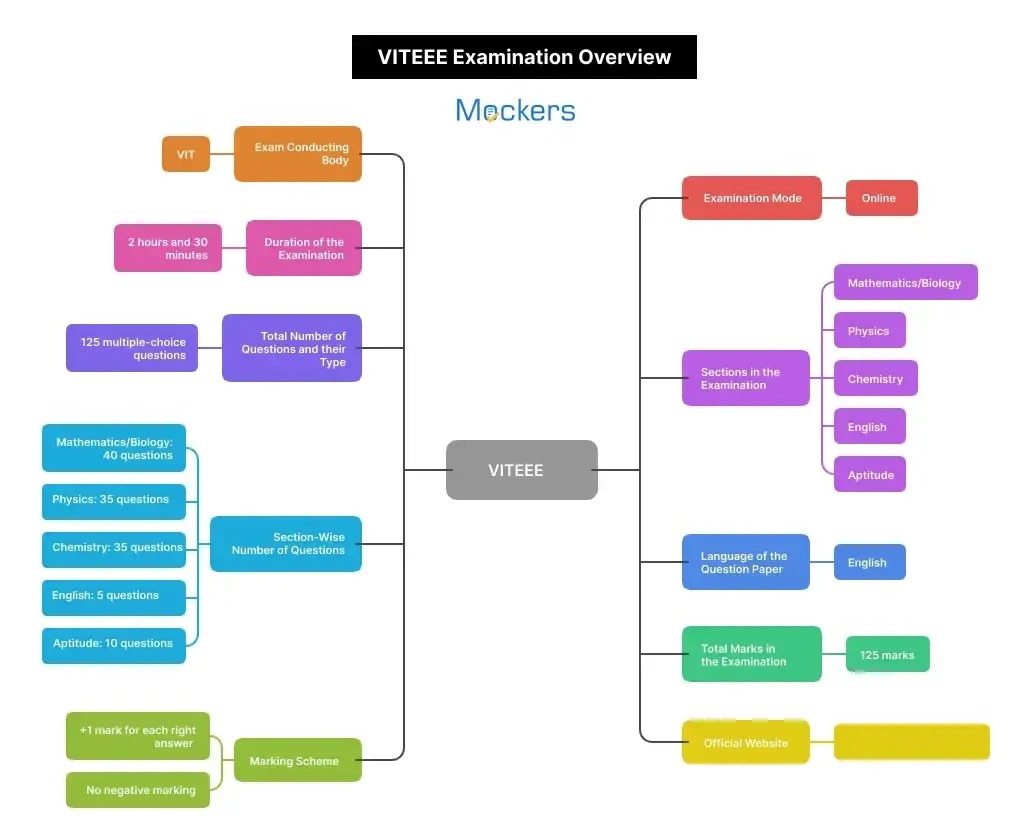
| ASPECT | DETAILS |
| Examination Name | VITEEE: Vellore Institute of Technology Engineering Entrance Examination |
| Exam Conducting Body | VIT: Vellore Institute of Technology |
| Level of the Examination | University level |
| Purpose of the Examination | Admission to undergraduate engineering programmes in the VIT group of Institutions.
|
| Examination Mode | Online (Computer-Based Test) |
| Duration of the Examination | 2 hours and 30 minutes |
| Sections in the Examination | 5 sections in total
|
| Total Number of Questions and their Type | 125 multiple-choice questions |
| Language of the Question Paper | English |
| Section-Wise Number of Questions |
|
| Total Marks in the Examination | 125 marks in total |
| Marking Scheme |
|
| Official Website | https://viteee.vit.ac.in/ |
Series Of VITEEE Mock Test 2026
Here, at Mockers, you will see that we have organized the VITEEE mock test free in 5 series. Every set includes the same number of questions, marks, and time limit as the actual exam. But the topics on which questions are framed in every test are different. By solving them, you will be able to increase your question bank as well as improve your problem-solving skills efficiently. For direct access to any of these tests, use the links mentioned below.
VITEEE Mock Test Free With Solutions
Each question in the VITEEE online mock test free comes with accurate solutions that are further explained properly by our team of subject-matter experts. This is done so that you can verify your responses and identify any errors that you made while solving the questions. Then, you can make any required changes in your study plans and focus on the weaker areas. All the solutions are available once you have submitted the test and verified your mobile number on the platform.
Eligibility Criteria For The VIT Engineering Entrance Examination
In order to apply for the Vellore Institute of Technology Engineering Entrance Examination, you must fulfill the following criteria.
Nationality
- A resident, non-resident Indian national, or one who holds an OCI/PIO, is eligible to apply for VITEEE.
- The ‘NRI category’ is where applicants can apply directly using the NRI application form.
- The international application form allows foreign applicants who are studying abroad to apply directly.
Age Limit
- The maximum age limit to apply for the VITEEE is 22 years. You will be disqualified if you don’t present the certificate in original form as identification at the time of counselling.
- The birthdate listed on your High School, SSC, or X certificate shall be accepted as genuine.
- At the time of counseling or admission, you must present this certificate in original form as proof of age; if you do not, then your candidature will be rejected.
Qualifying Examination
- You should have passed or shall be appearing in any of the following qualifying examinations in order to be eligible to take the VITEEE:
- The final exam of the 10+2 system, which is organized by any central or state board, such as the Central Board of Secondary Education, New Delhi, the Council for the Indian School Certificate Examinations, or any other board recognized by VIT as equivalent to the 10+2 exam.
- An intermediate or two-year pre-university exam administered by an accredited university or board.
- Advanced (A) level General Certificate Education (GCE) exam (London, Cambridge, Sri Lanka).
- High School Certificate Examination of the Cambridge University or International Baccalaureate Diploma of the International Baccalaureate Office, Geneva. Physics-HL/A, Mathematics-HL/A, Chemistry-SL/A/AS for PCM, and Physics-HL/A, Biology-HL/A, Chemistry-SL/A/AS for PCB.
- Senior Secondary School Examination from the National Institute of Open Schooling with a minimum of five subjects that are approved by the Central Board.
- If an applicant has passed the Class 12 or equivalent exam outside of India, they must present an equivalency certificate stating that their grade or CGPA is converted to a percentage and that their exam is equivalent to the Class 12 examination.
- Only candidates who have completed regular, full-time, and formal education are eligible to apply. Candidates are not eligible if they have taken more than one board exam in the same academic year.
- To be eligible for admission to B.Tech. programs, Indian citizens must attend VITEEE.
- Higher secondary marks may be used in place of the qualifying criteria if VITEEE is canceled for reasons beyond the institute’s control or because of natural disasters. Applicants will receive the appropriate information.
Requirement in the Qualifying Examination
- You must meet the requirements to be admitted to the university.
- You should have passed the qualifying examination (+2/Intermediate) with a minimum aggregate score of 60% in Physics, Chemistry, and Mathematics/Biology (PCM/PCB) in order to be admitted to the Undergraduate Engineering Program.
- Candidates seeking admission to the Undergraduate Engineering Program must have passed the qualifying exam (+2/Intermediate) with a minimum aggregate of 50% in Physics, Chemistry, and Mathematics/Biology for the following categories:
- Candidates belonging to the Scheduled Caste or the Scheduled Tribe category.
- Candidates from the Northeastern states of Arunachal Pradesh, Assam, Manipur, Meghalaya, Mizoram, Nagaland, Sikkim, and Tripura, as well as Jammu and Kashmir/Ladakh.
- At the time of counselling, a certificate proving community or nativity must be presented; otherwise, admission will not be considered.
Subject Eligibility
- All B.Tech. programs are open to PCMB/PCM applicants who took the Maths, Physics, Chemistry, English, and Aptitude (MPCEA) subjects in VITEEE.
- Only the following programs are available to PCMB/PCB applicants who have attempted Biology, Physics, Chemistry, English, and Aptitude (BPCEA) & PCB applicants who have attempted Mathematics, Physics, Chemistry, English, and Aptitude (MPCEA):
- B.Tech. Biotechnology (VIT, Vellore)
- B.Tech. Computer Science and Engineering (Bioinformatics), (VIT, Vellore)
- B.Tech. Electronics and Communication Engineering (Biomedical Engineering), (VIT, Vellore)
- B.Tech. Health Sciences and Technology (VIT, Vellore)
- B.Tech. Bioengineering (VIT, Bhopal)
- B.Tech. Computer Science and Engineering (Health Informatics), (VIT, Bhopal)
- B.Tech. Computer Science and Engineering (Education Technology), (VIT, Bhopal)
How To Access The VITEEE Online Mock Test Free On Our Website?
For the process that is necessary to access the VITEEE online mock test, you should go through the steps that are mentioned below one by one.
- Head to Mockers by typing www.mockers.in on your preferred search browser.

- There, your first click has to be on the ‘Navigation’ tab. It will be available in the top left corner of the screen.
- Then, you need to select the ‘Exam Categories’ section as shown below.

- This section will showcase a variety of categories related to different exams. Here, you should click on the ‘Engineering’ icon.
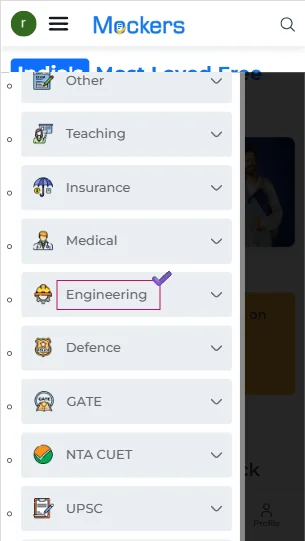
- Now, you can choose the ‘VITEEE’ option, and a new page with the VITEEE free mock test will be visible.
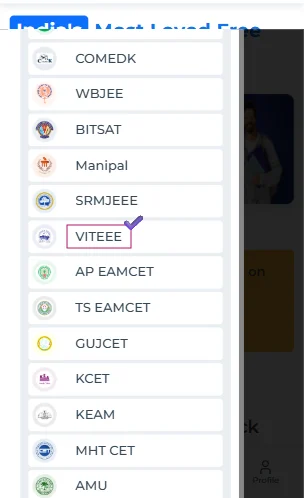
- You have to click on the ‘Explore’ button to access the series of VITEEE mock test papers online.
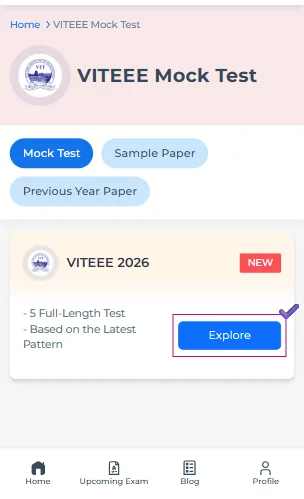
- At last, you can either start taking the VITEEE mock test papers with solutions one by one from the list or attempt any of your choice.
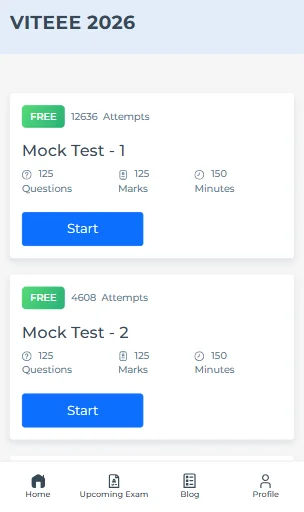
- Just read the given instructions for the VITEEE mock test to attempt it successfully.
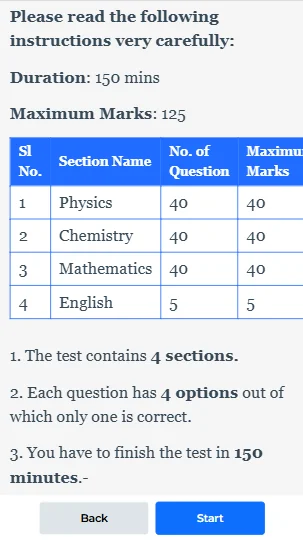
What Is The Process To Apply For The VIT Engineering Entrance Examination?
The entire application and admission process for the VITEEE is described with the help of the steps mentioned below.
ONLINE APPLICATION FORM
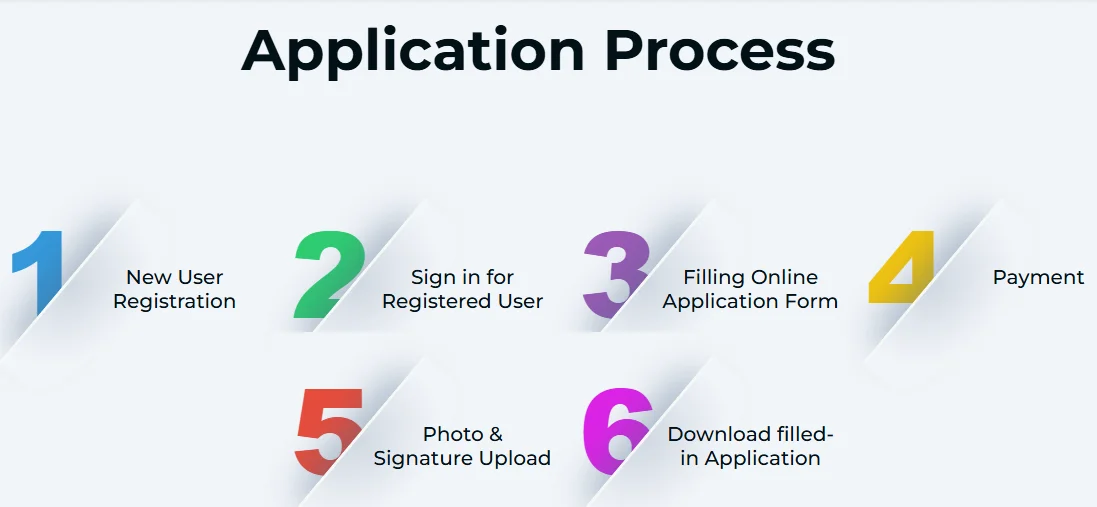
Step 1: New user registration
- You must have a working mobile number and a valid email address. You should enter all the relevant details carefully.
- Your registered Indian mobile number will receive an OTP for validation. Your registered email address will receive a password after the OTP has been verified.
- Only the registered email address and mobile number may be used for correspondence.
Step 2: Sign in for registered users
- You need to have an active mobile number and a valid email address.
Step 3: filling online application form
- Prior to filling out the application, you must read the content of the declaration and acknowledge its contents completely. Any discrepancy between the information on the application and the supporting documentation submitted at the time of application, counseling, or admission will result in the cancellation of the candidature and no reimbursement of the application cost.
- You need to carefully fill in the appropriate fields. Once the essential details have been filled out, an application number will be generated.
- The annexure contains a list of the Boards and their corresponding codes. In the qualifying exam, the board code of study should be mentioned properly. Admission will be cancelled if there is any discrepancy between the application form filled out on the board and the relevant documents submitted at the time of admission.
Step 4: Payment
- The INR 1,350 application fee must be paid with Net Banking, a credit card, a debit card, or Paytm.
- Overseas test centers require payment of a charge equal to USD 90 in Indian Rupees.
Step 5: Photo and signature upload
- Your photograph needs to be in color and professionally taken in a studio that meets the following requirements:
- The photo should be taken against a light background. The only acceptable background is white or off-white.
- The full-frontal view, with both ears visible, open eyes, and a neutral expression, must be captured in the photograph.
- Make sure that there is no blur in the focus and no glare from glasses. The only acceptable file format is JPEG.
- The photo’s file size should be between 20 and 300 kB. The photograph should have the proper amount of exposure, neither too bright nor too dark. There should be only one face in the picture.
- Signature uploading procedure
- On an A4 piece of white paper, create a rectangle box that is 6cm wide by 2cm high. Sign inside the box using a black or dark blue pen.
- Use a scanner to scan the signature in .jpeg format, then crop the picture.
- You can use Microsoft Paint to open the scanned signature image and crop it to fit the specific rectangular box that was previously signed and marked on the A4 white paper.
- The size of the scanned signature image should be between 5 and 150 kB.
Step 6: Download the filled-in application form
- Save the completed application form on your device for future use and reference.
- It is not necessary for applicants to provide VIT with a paper copy of their completed application.
ADMISSION PROCESS
With the help of the image displayed below, you can learn the VITEEE admission process.
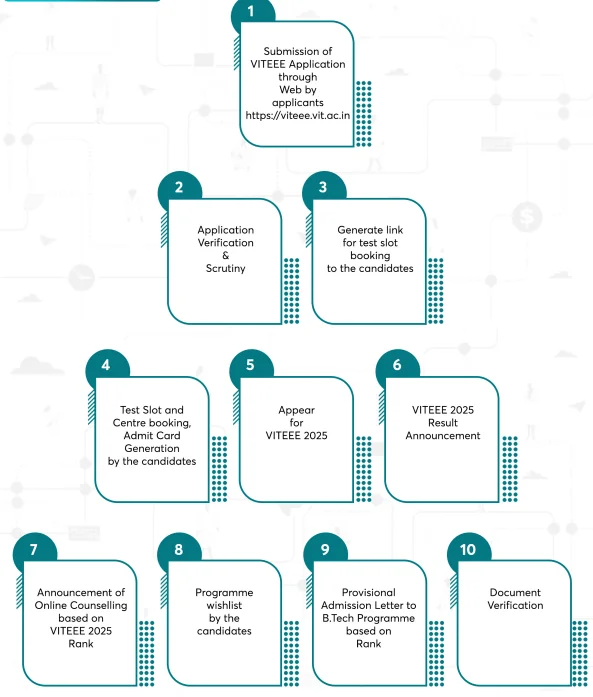
Programs Offered Through The VITEEE
In the table below, we have mentioned all the engineering programs that are offered across all the VIT group of Institutions.
| VIT VELLORE | ||
| B.Tech. Biotechnology | B.Tech. Chemical Engineering | B.Tech. Civil Engineering |
| B.Tech Civil Engineering (in collaboration with L&T) | B.Tech. Computer Science and Engineering | B.Tech. Computer Science and Engineering (Artificial Intelligence and Machine Learning) |
| B.Tech. Computer Science and Engineering (Artificial Intelligence and Data Engineering) | B.Tech. Computer Science and Engineering (Bioinformatics) | B.Tech. Computer Science and Engineering (Cyber Security) |
| B.Tech. Computer Science and Engineering and Business Systems (in collaboration with TCS) | B.Tech. Computer Science and Engineering (Data Science) | B.Tech. Electrical and Electronics Engineering |
| B.Tech. Electrical and Computer Science Engineering | B.Tech. Electronics and Communication Engineering | B.Tech. Electronics and Instrumentation Engineering |
| B.Tech. Electronics and Communication Engineering (Biomedical Engineering) | B.Tech. Electronics Engineering (VLSI Design and Technology) | B.Tech. Health Sciences and Technology |
| B.Tech. Information Technology | B.Tech. Mechanical Engineering | B.Tech. Mechanical Engineering (Electric Vehicles) |
| B.Tech. Mechanical Engineering (Smart Manufacturing) | ||
| VIT CHENNAI | ||
| B.Tech Civil Engineering | B.Tech Civil Engineering (in collaboration with L&T) | B.Tech. Computer Science and Engineering |
| B.Tech. Computer Science and Engineering (Artificial Intelligence and Machine Learning) | B.Tech. Computer Science and Engineering (Artificial Intelligence and Robotics) | B.Tech. Computer Science and Engineering (Cyber Physical Systems) |
| B.Tech. Computer Science and Engineering (Cyber Security) | B.Tech. Computer Science and Engineering (Data Science) | B.Tech. Electrical and Electronics Engineering |
| B.Tech. Electrical and Computer Science Engineering | B.Tech. Electronics and Communication Engineering | B.Tech. Electronics and Computer Engineering |
| B.Tech. Electronics Engineering (VLSI Design and Technology) | B.Tech. Fashion Technology | B.Tech. Mechanical Engineering |
| B.Tech. Mechatronics and Automation | B.Tech. Mechanical Engineering (Electric Vehicles) | |
| VIT AP | ||
| B.Tech. Computer Science and Engineering | B.Tech. Computer Science and Engineering (Artificial Intelligence and Machine Learning) | B.Tech. Computer Science and Engineering (Blockchain) |
| B.Tech. Computer Science and Engineering (Cyber Security) | B.Tech. Computer Science and Engineering (Data Analytics) | B.Tech. Computer Science and Engineering (Software Engineering) |
| B.Tech. Computer Science and Business Systems | B.Tech. Electronics and Communication Engineering | B.Tech. Electronics and Communication Engineering (Embedded Systems) |
| B.Tech. Electronics and Communication Engineering (VLSI) | B.Tech. Mechanical Engineering | B.Tech. Mechanical Engineering (Automotive Design) |
| B.Tech. Mechanical Engineering (Robotics) | ||
| VIT BHOPAL | ||
| B.Tech. Aerospace Engineering | B.Tech. Bioengineering | B.Tech. Computer Science and Engineering |
| B.Tech. Computer Science and Engineering (Artificial Intelligence and Machine Learning) | B.Tech. Computer Science and Engineering (Cloud Computing and Automation) | B.Tech. Computer Science and Engineering (Cyber Security and Digital Forensics) |
| B.Tech. Computer Science and Engineering (E-Commerce Technology) | B.Tech. Computer Science and Engineering (Education Technology) | B.Tech. Computer Science and Engineering (Gaming Technology) |
| B.Tech. Computer Science and Engineering (Health Informatics) | B.Tech. Electronics and Communication Engineering | B.Tech. Electronics and Communication Engineering (Artificial Intelligence and Cybernetics) |
| B.Tech. Mechanical Engineering | B.Tech. Mechanical Engineering (Artificial Intelligence and Robotics) | |
VITEEE Fee Structure
The table below describes the structure of fees at various campuses of Vellore Institute of Technology.
| PARICULARS | GROUP A | GROUP B |
| Tuition fees | 1,73,000 | 1,95,000 |
| Caution deposit | 3,000 | 3,000 |
| Total | 1,76,000 | 1,98,000 |
| Note: VIT Bhopal includes an additional INR 3,000 in Group B tuition fees. | ||
| GROUP A Programs | Bioengineering, Biotechnology, Chemical Engineering, Civil Engineering, Electrical and Electronics Engineering, Electronics and Instrumentation Engineering, Fashion Technology, Health Sciences and Technology | |
| GROUP B Programs | Aerospace Engineering, Computer Science, and Engineering and Business Systems (in collaboration with TCS), Computer Science & Engineering (E-Commerce Technology), Computer Science & Engineering (Education Technology), Computer Science and Engineering, Computer Science and Engineering (Artificial Intelligence and Machine Learning), Computer Scienceand Engineering (Artificial Intelligence and Robotics), Computer Science and Engineering (Artificial Intelligence and Data Engineering), Computer Science and Engineering (Bioinformatics), Computer Science and Engineering (Block chain), Computer Science and Engineering (Cloud Computing & Automation), Computer Science and Engineering (Cyber Physical Systems), Computer Science and Engineering (Cyber Security & Digital Forensics), Computer Science and Engineering (Cyber Security), Computer Science and Engineering (Data Analytics), Computer Science and Engineering (Data Science), Computer Science and Engineering (Gaming Technology), Computer Science and Engineering (Health Informatics), Computer Science and Engineering (Software Engineering), Computer Science and Engineering and Business Systems, Electrical and Computer Science Engineering, Electronics and Communication Engineering, Electronics and Communication Engineering (Artificial Intelligence & Cybernetics), Electronics and Communication Engineering (Biomedical Engineering), Electronics and Communication Engineering (Embedded systems), Electronics and Communication Engineering (VLSI), Electronics and Computer Engineering Electronics Engineering (VLSI Design and Technology), Information Technology, Mechanical Engineering, Mechanical Engineering (Artificial Intelligence & Robotics), Mechanical Engineering (Automotive Design), Mechanical Engineering (ElectricVehicles), Mechanical Engineering (Smart Manufacturing), Mechanical Engineering (Robotics) Mechatronics and Automation | |
Benefits Of Taking The VITEEE Online Mock Test
Including the VITEEE mock test free into your daily study plan can increase your chances of success in the exam significantly. The benefits that this resource offers are mentioned below for your reference.
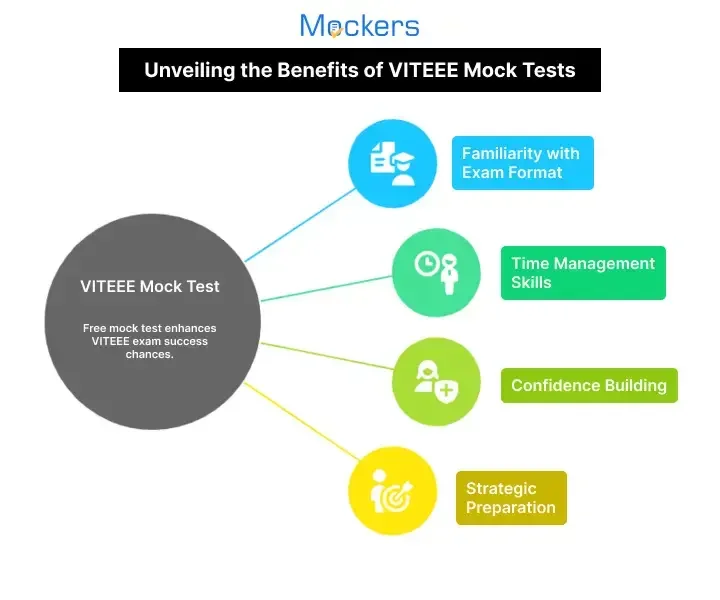
- By attempting the VITEEE online mock test free, you get familiar with the format, structure, as well as timing of the actual exam. It also helps you develop an intuitive understanding of the questions’ flow, which makes you feel less anxious and more confident on exam day. This allows you to learn how to prioritize sections on the basis of their difficulty level.
- One great challenge that you students face in exams like VITEEE is time management. The VITEEE online mock test mirrors the exact exam environment, where you have to complete 125 questions within a set time. This time pressure enables you to pace yourself like, knowing when to move on from a difficult question, how to manage overall time allocation, and so on.
- With the VITEEE free mock test, you get valuable insights into which subjects or question types you excel at and which need more attention. The immediate feedback that you get through the tests highlights patterns of your mistakes. You can easily understand whether you are making conceptual errors or just rushing through the questions. Then, you can do a more targeted revision and focus on the weaker areas for maximum improvement.
- Exam anxiety is an issue that many students face. But with regular attempts at the VITEEE mock test papers online and VITEEE previous year papers, you will be able to simulate the high-pressure atmosphere of the exam, which will reduce your nerves as well as stress. Moreover, test format familiarization and practicing under timed conditions will allow you to remain calm and focused when the real exam day arrives.
- In the VIT Engineering Entrance Examination, you are required to solve problems quickly and accurately. With the help of the VITEEE mock test papers with solutions, you are able to improve both your speed as well as accuracy. As you keep practicing, you will start to recognize patterns in the question types that are asked, and this repetition will lead you to faster recall of formulas, concepts, methods, etc. Additionally, continuous practice will enhance your problem-solving abilities, with which you can reduce mistakes in the process.
VIT Engineering Entrance Examination Selection Criteria
The guidelines for admission through the VITEEE (Vellore Institute of Technology Engineering Entrance Examination) are given in detail below.
- The rank obtained by the CBT (Computer-Based Test) VITEEE is the basis for selection.
- Depending on the ranking, chosen candidates can take part in online counselling. You are able to provide options for particular campuses, programs, and cost categories. The available options and the rank earned will determine the allotment.
- VIT- Vellore, VIT- Chennai, VIT- AP, and VIT- Bhopal are the four campuses where candidates with ranks up to 1 lakh are eligible for counseling. The VIT- AP and VIT- Bhopal campuses offer counseling to rank holders up to 1.5 lakh. Only those with ranks greater than 1.5 lakh are eligible for counseling at the VIT- AP campus.
- Once you have paid your tuition fees by the deadline, VIT will confirm your eligibility. You must present your documentation when you report to campus or as requested by the admissions office. Only when eligibility is met will the provisional admission provided during counseling be considered valid.
Syllabus For The Exam And VITEEE Mock Test
For your benefit, we have given details regarding the entire syllabus of the sections from which the questions are prepared in the real exam, as well as our VITEEE mock test. Go through the table below for a better understanding.
| SECTION | TOPICS/SUBTOPICS |
| PHYSICS | Mechanics and Properties of Matter
|
Electrostatics
|
|
Current Electricity & Magnetic Effects of Electric Current
|
|
Electromagnetic Induction and Alternating Current
|
|
Optics
|
|
Dual Nature of Radiation, Atomic & Nuclear Physics
|
|
Semiconductor Devices and Their Applications
|
|
| CHEMISTRY | Physical Chemistry
|
Inorganic and Material Chemistry
|
|
Analytical Chemistry
|
|
Basic Principles of Organic Chemistry
|
|
Properties and Chemistry of Functionalized Organic Compounds
|
|
Organic Nitrogen Compounds
|
|
Biomolecules and Polymers
|
|
| MATHEMATICS | Matrices and Their Applications
|
Trigonometry and Complex Numbers
|
|
Analytical Geometry of Two-Dimensions
|
|
Vector Algebra
|
|
Analytical Geometry of Three Dimensions
|
|
Differential Calculus
|
|
Integral Calculus and Its Applications
|
|
Differential Equations
|
|
Probability and Distributions
|
|
Discrete Mathematics
|
|
| BIOLOGY | Taxonomy
|
Cell and Molecular Biology
|
|
Reproduction
|
|
Genetics and evolution
|
|
Human health and diseases
|
|
Biochemistry
|
|
Plant physiology
|
|
Human physiology
|
|
Biotechnology and its applications
|
|
Biodiversity, ecology, and environment
|
|
| APTITUDE | Data Interpretation
|
Data Sufficiency
|
|
Syllogism
|
|
Number Series, Coding, and Decoding
|
|
Clocks, Calendars, and Directions
|
|
| ENGLISH | Multiple choice questions to test the comprehension of a short passage or line of poems, English grammar, and pronunciation. (The passages, lines of poems, dialogues, grammar, and pronunciation items are chosen to suit the level of higher secondary or equivalent education.). |
How To Use The VITEEE Free Mock Test Results For Focused Revision?
By using the results of your VITEEE mock test attempts for focused revision, you will be able to make a significant difference in your preparation. Below are some points on how to use these results.
- You should start by categorizing your VITEEE mock test 2026 results on the basis of correct and incorrect answers. By doing so, you can pinpoint specific topics or question types where you made errors. You can also break down into conceptual errors, calculation mistakes, or time management issues. Once you have done this, you should make a list of topics that require a deeper review and prioritize them.
- Finding your weaker areas is the most important use of your VITEEE mock test free results. After reviewing your wrong answers, you need to pinpoint the concepts or sections that are causing confusion.
- In case your VITEEE online mock test free results show that you are spending too much time on specific sections or questions, then it is necessary to address time management during your revision time.
- If you are making the same types of mistakes in multiple VITEEE online mock test, then it is a clear signal that those areas require focused revision. The patterns might include consistent incorrect questions from a particular chapter, recurring mistakes in question formats, failing questions from similar difficulty levels, etc.
- At Mockers, you get a detailed section-wise performance report for the VITEEE free mock test. You have to review these metrics to understand where you are strong and weak consistently. Then, you should prioritize revising the weak areas to reduce knowledge gaps.
Cities For The Vellore Institute of Technology Engineering Entrance Examination
Here is a list of all the cities where the authority conducts the VIT Engineering Entrance Examination.
| TEST CITIES | ||
| Andaman and Nicobar Islands: Sri Vijaya Puram (Port Blair) | Andhra Pradesh: Amaravati (AP), Anantapur, Eluru, Kurnool, Nellore, Rajamahendravaram, Srikakulam, Tirupati, Visakhapatnam | Arunachal Pradesh: Naharlagun |
| Assam: Dibrugarh, Guwahati, Silchar | Bihar: Bhagalpur, Gaya, Muzaffarpur, Patna | Chhattisgarh: Bhilai, Bilaspur, Raipur |
| Delhi: Delhi | Goa: Mapusa | Gujarat: Ahmedabad, Jamnagar, Rajkot, Surat, Vadodara |
| Haryana: Faridabad, Gurugram, Hisar, Kurukshetra | Himachal Pradesh: Shimla | Jammu & Kashmir: Jammu, Srinagar |
| Jharkhand: Bokaro, Dhanbad, Jamshedpur, Ranchi | Karnataka: Bengaluru, Hubbali, Mangaluru, Mysuru | Kerala: Ernakulam, Kannur, Kozhikode, Thiruvananthapuram, Thrissur |
| Madhya Pradesh: Bhopal, Gwalior, Jabalpur | Maharashtra: Amravati, Chhatrapati Sambhaji Nagar (Aurangabad), Latur, Mumbai, Nagpur, Nashik, Pune, Solapur, Thane | Manipur: Imphal |
| Meghalaya: Shillong | Mizoram: Aizawl | Nagaland: Kohima |
| Odisha: Brahmapur, Bhubaneswar, Rourkela | Puducherry: Puducherry | Punjab: Amritsar, Bathinda, Jalandhar, Ludhiana, Pathankot, Sahibzada Ajit Singh Nagar (Mohali) |
| Rajasthan: Ajmer, Bikaner, Jaipur, Jodhpur, Kota, Udaipur | Sikkim: Gangto | Tamil Nadu: Chennai, Coimbatore, Erode, Kancheepuram, Madurai, Nagercoil, Salem, Thanjavur, Tiruchirappalli, Tirunelveli, Vellore |
| Telangana: Hyderabad, Karimnagar, Khammam, Mahbubnagar, Nalgonda, Warangal | Tripura: Agartala | Uttar Pradesh: Agra, Aligarh, Bareilly, Gorakhpur, Ghaziabad, Jhansi, Kanpur, Lucknow, Mathura, Meerut, Moradabad, Prayagraj, Noida, Varanasi |
| Uttarakhand: Dehradun, Haldwani, Roorkee | West Bengal: Durgapur, Kolkata, Siliguri, Asansol | |
| ABROAD TEST CITIES | ||
| UAE - Dubai | Kuwait - Kuwait | Oman - Muscat |
| Qatar - Qatar | Malaysia - Kuala Lumpur | Singapore - Singapore |
| Bahrain - Manama | ||
Conclusion
Success in the exam is not just about how much you study. It is about how well you practice, and the VITEEE mock test papers online are the bridge between your preparation and performance. With them, you get a realistic simulation of the exam, which helps you fine-tune your time management, improve accuracy, reduce exam anxiety, build a smart test-taking strategy, and so on. Our mock tests are designed with the latest exam pattern, high-quality questions, as well as in-depth performance analysis to give you an edge over the competition.
 Bank
Bank







 SSC
SSC









 Railway
Railway







 State
State




 Other
Other


 Teaching
Teaching




 Insurance
Insurance


 Medical
Medical



 Engineering
Engineering




















 Defence
Defence





 GATE
GATE





 NTA CUET
NTA CUET

 UPSC
UPSC

 MBA Entrance
MBA Entrance

















 LAW
LAW

 JEE Main 2026 : Session 1
JEE Main 2026 : Session 1
 SSC MTS 2025
SSC MTS 2025
 IBPS RRB 2025
IBPS RRB 2025
 Railway Group D 2025
Railway Group D 2025
 RRB ALP CBT-I 2025
RRB ALP CBT-I 2025
 CTET 2025 Paper I
CTET 2025 Paper I
 UP Police SI (दरोगा) 2025
UP Police SI (दरोगा) 2025
 SSC CPO Tier I 2025
SSC CPO Tier I 2025
 DSSSB PRT 2025
DSSSB PRT 2025
 Delhi Police Constable 2025
Delhi Police Constable 2025
 SSC CGL Tier-II 2025
SSC CGL Tier-II 2025













 Get latest Exam Updates
Get latest Exam Updates 



